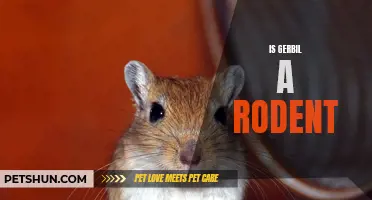
The habitat of the Mongolian gerbil is a fascinating and diverse environment that showcases the adaptability and resilience of this small rodent. From the sandy deserts of Mongolia to the rocky mountains and grasslands, these tiny creatures have found a way to survive and thrive in some of the harshest conditions on Earth. This article will explore the various features that make up the Mongolian gerbil's habitat and shed light on the unique adaptations they have acquired to conquer these challenging landscapes.
| Characteristics | Values |
|---|---|
| Country | Mongolia |
| Habitat | Desert, grasslands, scrublands |
| Climate | Arid |
| Temperature Range | 20°C to 35°C |
| Rainfall | Low |
| Landforms | Sand dunes, rocky outcrops |
| Vegetation | Sparse grasses, shrubs |
| Water Sources | Oases, shallow pools |
| Burrows | Extensive tunnel systems |
| Nesting Materials | Grass, leaves, fur |
| Predators | Birds of prey, snakes, foxes |
| Diet | Seeds, grains, insects, fruits |
| Social Behavior | Colonial |
| Reproduction | Monogamous, 4-6 pups per litter |
| Lifespan | 2-4 years |
| Conservation Status | Least Concern |
What You'll Learn
- What are the key elements of a suitable habitat for Mongolian gerbils?
- How does the natural habitat of Mongolian gerbils differ from a captive habitat?
- What types of nesting materials are recommended for Mongolian gerbils in their habitat?
- How should the temperature and humidity levels be regulated in a Mongolian gerbil habitat?
- What features should be included in a gerbil habitat to promote their physical and mental well-being?

What are the key elements of a suitable habitat for Mongolian gerbils?
Mongolian gerbils (Meriones unguiculatus) are small rodents that are commonly kept as pets. In order to provide them with a suitable habitat, there are several key elements that need to be considered. These include the size and design of the enclosure, the substrate, temperature and humidity, as well as enrichment and socialization opportunities.
The size and design of the gerbil enclosure is crucial for their well-being. Mongolian gerbils are highly active animals that require plenty of space to run, dig, and explore. The minimum recommended size for a gerbil enclosure is at least 10 gallons per gerbil, but larger is always better. The enclosure should also have a secure lid to prevent escapes.
The substrate in the gerbil enclosure is important for their natural digging behavior. Gerbils are desert-dwelling animals and need a deep layer of substrate to burrow in. A mix of aspen bedding and sand is often recommended, as it provides a soft and absorbent surface for digging. Avoid using pine or cedar bedding, as these can be harmful to the gerbils.
Maintaining the right temperature and humidity levels is also important for the health of the gerbils. The ideal temperature range for gerbils is between 68 and 78 degrees Fahrenheit (20-25 degrees Celsius). It's important to monitor the temperature and ensure that it doesn't fluctuate too much. Gerbils also prefer low humidity levels, ideally between 30-50%. Investing in a hygrometer can help monitor and maintain the proper humidity levels in the enclosure.
Enrichment and socialization are essential for the well-being of gerbils. These animals are highly social and thrive in pairs or small groups. It's important to provide them with plenty of toys, tunnels, and hiding places to keep them mentally and physically stimulated. Gerbils also enjoy having a solid exercise wheel to run on. Additionally, providing opportunities for social interaction and playtime outside of the enclosure can help keep gerbils happy and healthy.
In conclusion, creating a suitable habitat for Mongolian gerbils involves considering several key elements. These include providing a spacious enclosure with a secure lid, using an appropriate substrate for digging, maintaining the correct temperature and humidity levels, and providing enrichment and socialization opportunities. By providing a well-designed habitat, gerbil owners can ensure the health and happiness of their furry friends.
Battle of the Pets: Gerbils vs Rats - Which is the Better Companion?
You may want to see also

How does the natural habitat of Mongolian gerbils differ from a captive habitat?
Mongolian gerbils, also known as desert gerbils, are small rodents native to the semi-arid regions of Mongolia and surrounding areas. These gerbils have a unique natural habitat that differs significantly from a captive habitat. In this article, we will explore the various aspects of their natural habitat and how it contrasts with an artificial captive environment.
Climate and Geography:
Mongolian gerbils inhabit dry grasslands, deserts, and steppe regions characterized by low rainfall and extreme temperature fluctuations. These harsh conditions have shaped their physiology and behavior to endure long periods of drought and limited resources. In contrast, a captive habitat usually provides a controlled climate with stable temperatures and ample food and water supply.
Burrowing Behavior:
Gerbils are burrowing animals by nature and have evolved to construct complex tunnel systems in their natural habitat. These burrows serve as shelters from predators and extreme weather conditions, as well as a safe place to store food. In captivity, gerbils are often provided with artificial burrows, but they are limited in size and complexity compared to their natural burrow systems.
Exercise and Space:
In the wild, Mongolian gerbils have vast territories to forage for food and explore. This allows them to satisfy their natural instinct for exploration and exercise. In captivity, gerbils are usually confined to cages that provide limited space for exercise. This restriction can lead to stress, obesity, and other health issues if not properly addressed through sufficient opportunities for physical activity.
Diet and Foraging:
In their natural habitat, Mongolian gerbils have a diverse diet consisting of various seeds, plants, and insects. They are skilled foragers, constantly searching for food sources to sustain themselves. In captivity, gerbils are typically provided with a commercially prepared pellet diet, which lacks the variety and complexity of their natural diet. Providing gerbils with a range of fresh fruits, vegetables, and occasional treats can help replicate their natural foraging behavior.
Social Structure:
In the wild, Mongolian gerbils live in extended family groups, consisting of a dominant breeding pair and their offspring. These groups exhibit complex social behaviors and hierarchy. In captivity, gerbils are often housed in pairs or small groups, but it is essential to ensure proper social dynamics and prevent aggression. Providing enough hiding places, food and water sources, and ensuring ample space can help foster a healthy social environment for captive gerbils.
In conclusion, the natural habitat of Mongolian gerbils differs significantly from their captive habitat. Factors like climate, burrowing behavior, exercise, diet, and social structure all vary between the two environments. To ensure the well-being of captive gerbils, it is crucial to understand and provide for their natural instincts and behaviors as closely as possible. By recreating elements of their natural habitat in captivity, gerbil owners can help promote the health and happiness of these fascinating rodents.
The Surprising Size of Gerbils: How Big Can They Really Get?
You may want to see also

What types of nesting materials are recommended for Mongolian gerbils in their habitat?
Mongolian gerbils, also known as desert gerbils, are small rodents native to the desert regions of Mongolia and China. These adorable creatures make great pets and require a comfortable and enriching habitat to thrive. One important aspect of their habitat setup is the choice of nesting materials. In this article, we will explore the various types of nesting materials that are recommended for Mongolian gerbils.
When it comes to selecting nesting materials for Mongolian gerbils, it is crucial to choose options that are safe, comfortable, and mimic their natural environment. Here are some recommended nesting materials:
- Shredded paper: Plain white paper or unprinted paper towels shredded into strips make excellent nesting materials for Mongolian gerbils. Ensure that you use materials that are non-toxic and free from any chemicals or dyes.
- Tissue paper: Soft tissues or toilet paper torn into small pieces are another great option for nesting materials. Mongolian gerbils enjoy shredding and burrowing into the paper, creating cozy nests for themselves.
- Bedding material: There are several bedding materials available in pet stores specifically designed for gerbils. Aspen shavings and paper-based beddings, such as Carefresh or Kaytee Clean & Cozy, are safe and comfortable choices for gerbil habitats. Avoid using cedar or pine shavings as they can be harmful to the gerbil's respiratory system.
- Hay: High-quality hay, such as timothy hay, can be provided as a nesting material for Mongolian gerbils. Not only does it provide a comfortable bedding option, but it also offers them a source of natural foraging behavior.
- Torn cardboard: Plain cardboard boxes or tubes torn into small pieces can be used as nesting materials. Gerbils enjoy chewing on cardboard, and these pieces can double as toys while providing them with a cozy nesting option.
- Torn or cut fabric: Soft, non-loose fabric can be used as nesting materials. Cut old t-shirts, fleece, or thin cotton fabric into small pieces and provide them to your gerbil. Ensure that the fabric does not have loose threads that could potentially wrap around their limbs or cause injury.
It is important to regularly monitor the nesting materials in your gerbil's habitat. Remove any soiled or damp materials to maintain a clean and hygienic environment for your pet. Additionally, provide ample nesting materials to allow your gerbil to build multiple nests throughout its habitat.
Remember, each gerbil has its own preference when it comes to nesting materials. Some may prefer paper, while others may enjoy burrowing into hay. It is essential to observe your gerbil's behavior and adjust the materials accordingly to ensure their comfort and well-being.
In conclusion, providing suitable nesting materials is vital for the overall welfare and enrichment of Mongolian gerbils. By offering options such as shredded paper, tissues, bedding materials, hay, torn cardboard, and cut fabric, you can create a cozy and stimulating environment for your furry friend. Remember to prioritize safety and cleanliness by regularly checking and replacing nesting materials as needed. Your gerbil will appreciate having a comfortable and secure nest to call home.
Are Gerbils Social Animals? Exploring Whether Gerbils Can Live Together
You may want to see also

How should the temperature and humidity levels be regulated in a Mongolian gerbil habitat?
Temperature and humidity regulation are important aspects to consider when creating a suitable habitat for Mongolian gerbils. These small rodents are native to the arid regions of Mongolia and are adapted to withstand extreme temperature fluctuations. However, providing optimal temperature and humidity levels in captivity is essential for their overall well-being and health.
Mongolian gerbils are known for their ability to tolerate low temperatures, but they are also susceptible to heat stress. The ideal temperature range for gerbils is between 20-24 degrees Celsius (68-75 degrees Fahrenheit). It is important to ensure that their habitat is not exposed to direct sunlight or drafts, as these can lead to temperature extremes. Placing the gerbil enclosure in a quiet area of the house away from windows or heating/cooling vents can help maintain a stable temperature.
In colder climates, a heat source may be required to keep the gerbil habitat at a suitable temperature. This can be achieved by using an under-tank heating pad or a ceramic heat emitter. It is crucial to monitor the temperature closely to prevent overheating or chilling of the gerbils. Using a digital thermometer with a probe can help accurately measure the temperature at the gerbils' level.
Humidity regulation is also important for the health of Mongolian gerbils. These desert-dwelling animals are accustomed to low humidity levels. The ideal range for gerbils is between 30-50% relative humidity. Excessive humidity can lead to respiratory issues and fungal growth, while too little humidity can cause skin dryness and respiratory discomfort.
To maintain optimal humidity levels, it is advisable to use a hygrometer to monitor the humidity in the gerbil habitat. If the humidity is too high, reducing the humidity can be achieved by improving ventilation and airflow within the enclosure. Placing a small fan near the enclosure can help circulate air and lower the humidity level.
In contrast, if the humidity is too low, providing a shallow water dish or using a humidifier can help increase the moisture in the gerbil habitat. It is important to ensure that the water dish is small and shallow to prevent flooding or accidental submersion. Adding a water bottle with a chew-proof metal spout is another option for providing water while maintaining optimal humidity levels.
It is essential to regularly check the temperature and humidity levels in the gerbil habitat to ensure they remain within the recommended ranges. Sudden changes in temperature or humidity can stress the gerbils and lead to health problems. Keeping a log of temperature and humidity readings can help identify any patterns or deviations from the ideal ranges.
In conclusion, regulating temperature and humidity levels in a Mongolian gerbil habitat is crucial for their overall well-being. Maintaining a stable temperature between 20-24 degrees Celsius and relative humidity between 30-50% will provide a comfortable and healthy environment for these desert-dwelling rodents. Monitoring temperature and humidity with the help of digital thermometers and hygrometers, and making adjustments as necessary, will ensure the best possible living conditions for the gerbils.
What You Need to Consider When Deciding How Many Gerbils to Get
You may want to see also

What features should be included in a gerbil habitat to promote their physical and mental well-being?
A gerbil habitat plays a crucial role in promoting the physical and mental well-being of these small rodents. Gerbils are active creatures that require plenty of space, mental stimulation, and opportunities for exercise. Creating a gerbil habitat with all the necessary features will ensure their overall health and happiness.
One essential feature of a gerbil habitat is ample living space. Gerbils are social animals and thrive when they have enough room to interact and explore. The habitat should be spacious enough to accommodate multiple gerbils if you plan to keep more than one. A general rule of thumb is to provide a minimum floor space of 10-20 gallons per gerbil. This will give them enough space to run, dig, and play.
Another important feature to include in a gerbil habitat is a solid enclosure. Gerbils are known for their digging abilities, and they can easily escape through pliable materials such as plastic or wire mesh. Opting for a glass or Plexiglas enclosure will prevent any potential escapes. Ensure that the lid is secure and has proper ventilation to maintain a healthy airflow.
Gerbils are natural burrowers, so it is crucial to provide them with bedding materials that simulate their natural habitat. Materials such as aspen shavings, shredded paper, or hay work well as bedding options and allow gerbils to burrow and create comfortable nest areas. Avoid using cedar or pine shavings, as the aromatic oils can be harmful to their respiratory system.
To keep gerbils physically active, the habitat should have various toys and accessories. A solid exercise wheel is a must-have item, as gerbils love to run on wheels for hours. Ensure that the wheel is appropriately sized to avoid any potential back injuries. Additionally, provide chew toys made of safe materials like untreated wood or hard plastic. These toys help keep their teeth healthy and prevent boredom.
Incorporating tunnels and hiding spots provides mental stimulation and enrichment for gerbils. Tubes made of cardboard or plastic can be connected to the habitat, creating a maze-like structure. This encourages exploratory behaviors and gives the gerbils a sense of security. Additionally, providing multiple hiding spots, such as wooden houses or small caves, gives gerbils a place to retreat and feel safe.
To maintain their overall health, gerbils require a balanced diet and access to fresh water. Provide a sturdy food dish to prevent tipping and contamination of their food. Offer a commercial gerbil pellet as the main source of nutrition, along with occasional treats such as fruits, vegetables, and seeds. Always ensure a fresh supply of clean water is available through a water bottle with a sipper tube.
In conclusion, a well-designed gerbil habitat should include ample living space, a secure enclosure, appropriate bedding materials, exercise toys, tunnels, hiding spots, and a balanced diet. Providing these features will promote the physical and mental well-being of gerbils, enabling them to live happy and healthy lives. Remember to regularly clean the habitat to maintain a hygienic environment for your furry friends.
Understanding Gerbil Behavior: What You Need to Know
You may want to see also
Frequently asked questions
When setting up a Mongolian gerbil habitat, it is important to consider the size and type of enclosure. Gerbils are active creatures, so their habitat should be spacious enough for them to run, burrow, and play. A glass aquarium or a wire cage with a solid bottom is a good choice.
It is recommended to use a bedding material that is safe and can provide comfort for the gerbils. Aspen shavings, paper-based bedding, or Timothy hay are popular choices. Avoid using cedar or pine shavings, as these can be harmful to gerbils' respiratory systems.
Yes, Mongolian gerbils are active and curious creatures that require mental stimulation and enrichment in their habitat. Providing them with toys, such as tunnels, exercise wheels, and chew toys, can help prevent boredom and promote physical activity.
Mongolian gerbils are adapted to survive in desert-like environments, so it is important to provide them with a habitat that mimics these conditions. The temperature should be kept between 68-75 degrees Fahrenheit (20-24 degrees Celsius). It is also recommended to provide them with natural or full-spectrum lighting to simulate daylight.







